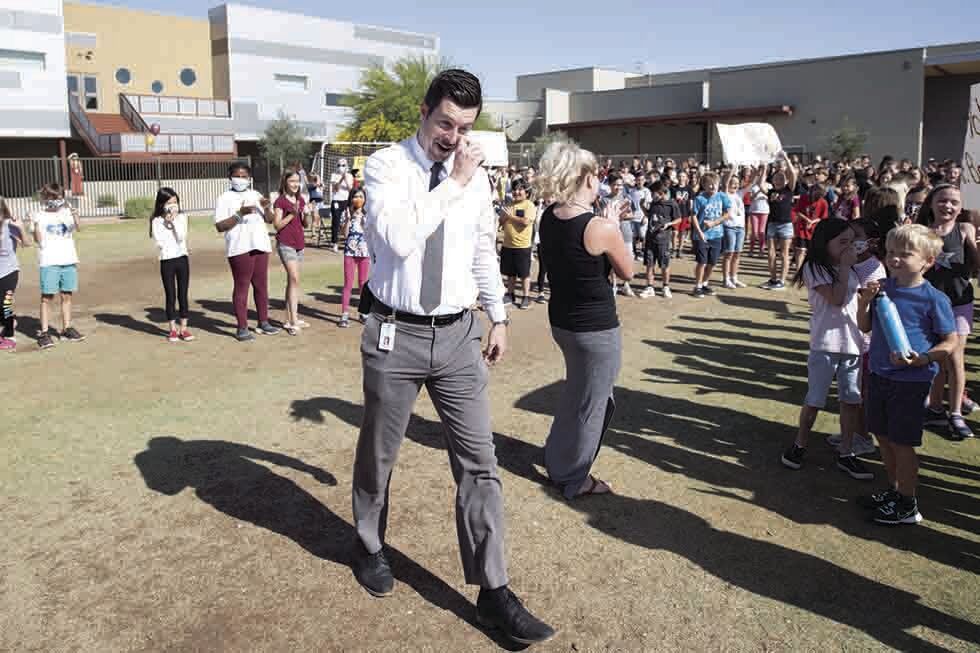Analysis of Arizona’s Public Education System in the Context of Sustainable Development Goals
National Ranking and Implications for SDG 4
A recent national assessment of public education systems positions Arizona at 48th, highlighting significant challenges in achieving Sustainable Development Goal 4 (SDG 4): Quality Education. The analysis, conducted by WalletHub, evaluated all 50 states and the District of Columbia on metrics related to educational quality and safety. Arizona’s overall score of 37.70 reflects deep-seated issues that impede progress toward providing inclusive and equitable quality education for all.
- Overall Rank: 48th
- School Quality Rank: 47th
- School Safety Rank: 44th
These rankings suggest a systemic failure to meet the core tenets of SDG 4, which advocates for ensuring all learners acquire the knowledge and skills needed to promote sustainable development.
Key Deficiencies and Alignment with SDG 4 Targets
The report identifies several critical areas where Arizona’s performance directly contravenes specific targets within SDG 4. These deficiencies create barriers to lifelong learning opportunities and contribute to poor socioeconomic outcomes, undermining SDG 8 (Decent Work and Economic Growth) and SDG 10 (Reduced Inequalities).
- High Dropout Rates: In direct opposition to SDG Target 4.1, which aims to ensure all children complete free, equitable, and quality primary and secondary education, Arizona is tied for 47th in the nation for its high student dropout rate. This indicates a failure to retain students within the educational system.
- Inadequate Learning Environments: The state has the highest pupil-teacher ratio in the country. This metric is a critical indicator of educational quality and directly impacts SDG Target 4.a, which calls for building and upgrading education facilities that are child, disability, and gender-sensitive and provide safe, non-violent, inclusive, and effective learning environments for all. Overcrowded classrooms limit individualized instruction and strain educational resources.
- Poor Academic Achievement: Arizona’s ranking at 49th for lowest median ACT scores points to significant shortcomings in the quality of instruction and learning outcomes, a core component of SDG 4.
Resource Allocation, Inequality, and Institutional Strength
Financial Investment and SDG 10
While Arizona increased per-pupil spending by 5% in FY2024 to $12,371, this figure remains $4,906 below the national average. This chronic underfunding is a major obstacle to achieving SDG 4. The report reinforces that funding must be both adequate and targeted effectively to address inequalities, a principle central to SDG 10 (Reduced Inequalities). Expert commentary within the report notes that districts with high numbers of economically underprivileged students or students with special needs require greater investment to ensure equitable outcomes. Inadequate and poorly targeted funding weakens the state’s primary institutions for human capital development, impacting SDG 16 (Peace, Justice and Strong Institutions).
The Educator Crisis and SDG Target 4.c
A persistent teacher shortage presents a severe challenge to the state’s educational infrastructure, directly undermining SDG Target 4.c, which aims to substantially increase the supply of qualified teachers.
- For nine consecutive years, the Arizona School Personnel Administrators Association has documented a critical teacher shortage.
- In its most recent survey, 52.2% of teacher vacancies for the 2024-25 school year were filled by individuals not meeting standard teaching certification requirements.
- A total of 2,260 teaching positions remained unfilled, leaving many students without a qualified instructor.
This crisis in human resources for education demonstrates an urgent need for investment in teacher recruitment, development, retention, and support to build a resilient and effective education system.
Enrollment Trends and Alternative Education
Data indicates a significant decline in traditional public school enrollment, falling from 78.2% in the 2015-16 school year to 68.1% in the most recent school year. Concurrently, there has been a substantial increase in enrollment in the state’s Empowerment Scholarship Account (ESA) program since its statewide expansion in 2022. Enrollment grew from approximately 12,000 in 2022 to nearly 90,000 by May 2025. This trend suggests a growing number of families are seeking alternatives to a public school system perceived as failing to meet the standards of a quality education as defined by the SDGs.
SDGs Addressed in the Article
-
SDG 4: Quality Education
The entire article is centered on the quality of public education in Arizona. It discusses the state’s low national ranking (48th) based on metrics like school quality, test scores, dropout rates, and teacher qualifications. This directly aligns with the goal of ensuring inclusive and equitable quality education.
- The article highlights Arizona’s rank of 47th for “school quality.”
- It mentions issues like low ACT scores, high dropout rates, and a persistent teacher shortage, all of which are central to the quality of education.
-
SDG 10: Reduced Inequalities
The article touches upon inequalities within the education system. It notes that students from different socioeconomic backgrounds require different levels of support and that funding is not always allocated to address these needs effectively. This relates to the goal of reducing inequality within and among countries.
- The article quotes an expert stating that “school districts with large numbers of economically underprivileged and/or immigrant students or students with special needs who tend to need more intensive instruction.”
- It also points out that external factors like “socioeconomic background” have a significant impact on academic outcomes, highlighting an inequality issue.
Specific SDG Targets Identified
-
Target 4.1: By 2030, ensure that all girls and boys complete free, equitable and quality primary and secondary education leading to relevant and effective learning outcomes.
This target is relevant due to the article’s focus on poor learning outcomes and school completion rates in Arizona.
- The report notes Arizona has one of the “nation’s highest drop-out rates,” which directly contradicts the goal of completing secondary education.
- The state’s tie for “49th place for lowest median ACT scores” indicates that students are not achieving “relevant and effective learning outcomes.”
-
Target 4.a: Build and upgrade education facilities that are child, disability and gender sensitive and provide safe, non-violent, inclusive and effective learning environments for all.
The article explicitly mentions safety as a key metric in evaluating the education system, connecting directly to this target’s aim of providing safe learning environments.
- Arizona’s public school system was ranked 44th for “safety” in the WalletHub report.
- The evaluation used “school safety indicators” as one of its weighted metrics.
-
Target 4.c: By 2030, substantially increase the supply of qualified teachers…
A significant portion of the article is dedicated to Arizona’s “educator crisis,” which directly relates to the target of increasing the supply of qualified teachers.
- The article cites a “persistent teacher shortage in the state for nine consecutive years.”
- It states that for the 2024-25 school year, “52.2% [of filled vacancies] were filled by individuals who did not meet standard teaching requirements,” highlighting a lack of *qualified* teachers.
- The state has the “highest pupil-teacher ratio in the country,” indicating a severe shortage in the supply of teachers relative to students.
Indicators for Measuring Progress
-
Dropout Rate (Implied Indicator for Target 4.1)
The dropout rate is a direct measure of whether students are completing their secondary education.
- The article states that Arizona has “some of the nation’s highest drop-out rates, tying… for 47th.” This can be used as a baseline indicator to track progress.
-
Standardized Test Scores (Implied Indicator for Target 4.1)
Test scores are used to measure learning outcomes.
- The article mentions that Arizona tied for “49th place for lowest median ACT scores,” which serves as a specific, measurable indicator of academic performance.
-
Pupil-Teacher Ratio (Implied Indicator for Target 4.c)
This ratio is a key indicator of teacher supply and the resources available to students in the classroom.
- The article explicitly reports that Arizona has the “highest pupil-teacher ratio in the country.” This figure can be tracked over time to measure progress in increasing the teacher supply.
-
Proportion of Qualified Teachers (Implied Indicator for Target 4.c)
This measures the quality and training of the teaching workforce.
- The article provides a precise statistic: “52.2% [of filled vacancies] were filled by individuals who did not meet standard teaching requirements.” The percentage of teachers who *do* meet standard requirements is a critical indicator.
-
Per-Pupil Spending (Implied Indicator for multiple targets)
While the article notes that spending alone doesn’t guarantee quality, it is presented as a key financial input for the education system.
- The article specifies that in FY2024, Arizona spent “$12,371 per student,” which was “$4,906 below the national average.” This financial data can be used as an indicator of investment in education.
Summary of Findings
| SDGs | Targets | Indicators Identified in the Article |
|---|---|---|
| SDG 4: Quality Education | 4.1 Ensure completion of equitable and quality education with effective learning outcomes. |
|
| SDG 4: Quality Education | 4.a Build and upgrade education facilities to provide safe and effective learning environments. |
|
| SDG 4: Quality Education | 4.c Substantially increase the supply of qualified teachers. |
|
| SDG 10: Reduced Inequalities | (Implied) Reduce educational disparities for vulnerable groups. |
|
Source: gilbertsunnews.com







